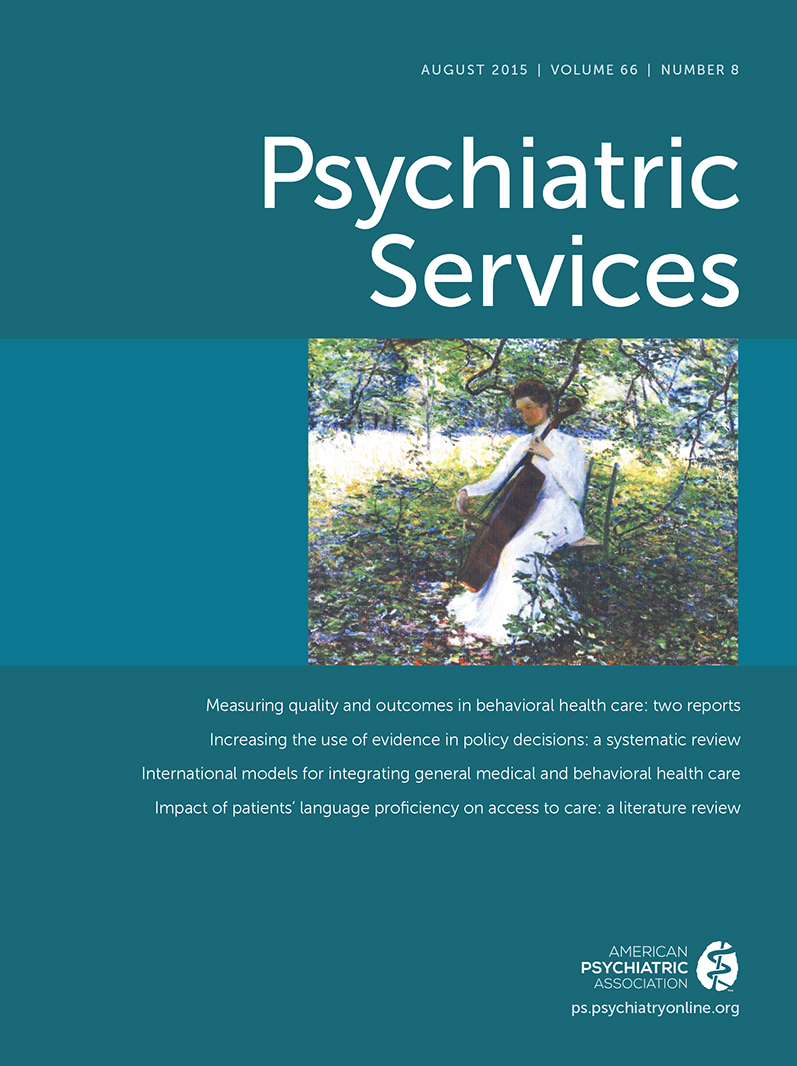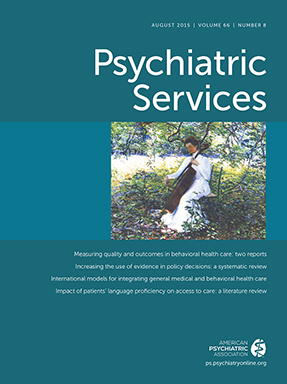APA practice guidelines for assessment of adults: The recently published
American Psychiatric Association Practice Guidelines for the Psychiatric Evaluation of Adults, Third Edition, is a set of nine guidelines that address the following topic areas: review of psychiatric symptoms, trauma history, and psychiatric treatment history; substance use assessment; assessment of suicide risk; assessment of risk for aggressive behaviors; assessment of cultural factors; assessment of medical health; quantitative assessment; involvement of the patient in treatment decision making; and documentation of the psychiatric evaluation. Each guideline includes a discussion of the rationale, potential benefits and harms, and approaches to implementing the guideline statements. A second section reviews the evidence for guideline statements in accord with national guideline development standards. The review is followed by a discussion of quality measurements. Publication of the new guidelines marks a transition in APA’s efforts in this area. Since the publication of the 2011 Institute of Medicine (IOM) report,
Clinical Practice Guidelines We Can Trust, there has been an increasing focus on using clearly defined, transparent processes for rating the quality of evidence and the strength of the overall body of evidence. APA’s guideline development process was designed to be consistent with the IOM recommendations, the
Principles for the Development of Specialty Society Clinical Guidelines of the Council of Medical Specialty Societies, and the requirements of the Agency for Healthcare Research and Quality for inclusion of a guideline in the National Guideline Clearinghouse. The guidelines can be accessed on the APA’s Web site at
psychiatryonline.org/guidelines.
New APA resources on mental health for faith leaders: The American Psychiatric Foundation has produced two new resources— a 20-page booklet,
Mental Health: a Guide for Faith Leaders, and a two-page companion to the guide,
Quick Reference on Mental Health for Faith Leaders—to help faith leaders better understand mental illness and treatment and help individuals and families in their congregations. Many people facing a mental health challenge turn first to a faith leader, and for many receiving psychiatric care, religion and spirituality are an important part of healing. In their role as “first responders,” faith leaders can help dispel misunderstandings, reduce stigma associated with mental illness and treatment, and facilitate access to treatment for those in need. The guide is intended to provide faith leaders with the knowledge, tools, and resources to support that role. The new resources are available on the APA Web site at
www.psychiatry.org/faith.
Poster on patients’ parity rights now available in Spanish: Federal law is clear that insurers can no longer discriminate against patients with mental illnesses. A poster produced by APA to inform patients of their rights under the Mental Health Parity and Addiction Equity Act is now available in Spanish as well as English. The poster describes patients’ rights in easy-to-understand language and notes steps to take when violations are suspected. Health care professionals are encouraged to download the poster and hang it prominently in offices or clinics or use it as a handout. The link can be forwarded to others in the community, such as employers and members of the clergy. The poster can be downloaded at
www.psychiatry.org/practice/parity.
New AHRQ statistics on hospital care for mental and substance use disorders: Nearly one in three hospital stays in 2012 involved at least one mental or substance use disorder diagnosis, accounting for 8.6 million hospital stays in 2012 (32% of all inpatient stays), according to a new report in the Statistical Briefs series from the Agency for Healthcare Research and Quality,
Hospitalizations Involving Mental and Substance Use Disorders Among Adults, 2012 (
www.hcup-us.ahrq.gov/reports/statbriefs/statbriefs.jsp). Nearly 1.8 million inpatient stays were for patients with a primary diagnosis of a mental or substance use disorder (nearly 7% of all stays). The average stay was longer for patients with a primary behavioral health diagnosis than for those with other primary diagnoses (6.6 versus 4.8 days), but total costs were lower for the former group ($6,300 versus $12,600). Insurance did not cover 13.9% of stays for patients with a primary behavioral health diagnosis, compared with 6.0% of stays for patients with other primary diagnoses. Taken together, government payers covered 56.0% of all inpatient stays with a primary mental or substance use disorder diagnosis, including those with co-occurring disorders. Another recently published brief in the series,
Characteristics of Hospital Stays for Super-Utilizers by Payer, 2012, reports that among Medicaid patients younger than 65, mood disorder was the most common diagnosis for “super-utilizers”—those with four or more hospital stays.
SAMHSA’s “snapshot” of the nation’s behavioral health: The
Behavioral Health Equity Barometer, United States, 2014, recently published by the Substance Abuse and Mental Health Services Administration (SAMHSA), is a one-year snapshot of the state of behavioral health of U.S. youths and adults. The 15-page report is based on a set of indicators measured in SAMHSA’s National Survey on Drug Use and Health. The report identifies gaps in prevalence rates and receipt of treatment by health insurance status and for specific ethnic and racial populations. According to the report, adults (≥18 years) without health insurance were significantly more likely to have experienced a serious mental illness in the past year than adults with health insurance (5.9% versus 3.9%). Among people reporting a serious mental illness, adults without insurance were less likely than those with insurance to receive treatment or counseling in the past year, (50.6% versus 73.5%). “These findings . . . provide crucial insight as to how we must all work together to provide the highest quality behavioral health care services for all segments of our community,” said SAMHSA Administrator Pamela S. Hyde, J.D. In accordance with the Affordable Care Act (ACA), SAMHSA created the Office of Behavioral Health Equity to coordinate agency efforts to address behavioral health disparities and advance behavioral health equity. The report is available on the SAMHSA site at
www.samhsa.gov/data/sites/default/files/Health_Equity_National_BHB/Health_Equity_National_BHB.pdf.
NASMHPD’s Early Intervention in Psychosis (EIP) Virtual Resource Center: With support from the Robert Wood Johnson Foundation (RWJF), the National Association of State Mental Health Program Directors (NASMHPD) has created an online collection of materials designed to provide reliable information for practitioners, policy makers, individuals, families, and communities to foster more widespread adoption and utilization of early intervention programming for persons at risk of or experiencing a first episode of psychosis. Recent research has demonstrated that early intervention can help prevent the full onset of illness for persons in a high-risk state and improve long-term outcomes for those who have had a first episode. The research has led to the development of programs with the potential to benefit millions of youths and young adults with or at risk of psychosis. The site includes information from a national RWJF-funded demonstration to identify and prevent the onset of psychotic illness—the Early Detection and Intervention for the Prevention of Psychosis Program (EDIPPP)—as well as other early intervention initiatives. The EIP Virtual Resource Center can be accessed from the NASMHPD site (
www.nasmhpd.org/content/early-intervention-psychosis-eip).
New CMS bulletin on Medicaid financing for housing-related services: The U.S. Centers for Medicare and Medicaid Services (CMS) has released an Informational Bulletin outlining the specific housing-related activities and services that can be reimbursed for Medicaid-covered individuals with disabilities. These include transition to housing and housing retention services for preventing and ending homelessness among individuals with disabilities. The primary audience for the bulletin is state Medicaid agencies. To help housing and other service providers reach out to Medicaid officials and use the bulletin as an impetus for discussions of improved benefit packages that include housing services, the Technical Assistance Collaborative (TAC) has developed a policy and program alert. The alert notes that release of the bulletin “signals CMS’s support of housing and community integration by outlining how Medicaid can be used to this end.” TAC’s alert includes links to resources on how to incorporate Medicaid financing into supportive housing services, as well as contact information for individuals in key housing and homeless prevention organizations. Both the CMS Informational Bulletin and TAC’s alert are available on the TAC Web site (
www.tacinc.org/knowledge-resources/news/cms-housing-info-bulletin).
Kaiser Foundation brief examines second year of ACA coverage expansions in five states: As of spring 2015, states had completed the second open enrollment period for the new health insurance marketplaces established by the ACA, and most of the 30 states that adopted the Medicaid expansion to low-income adults were well into their second year of implementation, with a few implementing the expansion more recently. A new issue brief from the Kaiser Family Foundation draws upon 40 in-person interviews conducted with a variety of stakeholders to assess experiences in five states during the second year of coverage expansions under the ACA. The interviews took place in three states with state-based marketplaces and expanded Medicaid programs—Colorado, Kentucky, and Washington—and in two states that use the federally facilitated marketplace and have not expanded Medicaid—Utah and Virginia. In the second year, according to the report, messaging moved away from raising awareness of coverage availability to personal testimonials and emphasis on the importance of coverage and to increasing health care literacy among newly insured adults. Marketplace enrollment goals were met or surpassed in all the states except Washington, according to the brief, but affordability remains a challenge. The three Medicaid expansion states reported that per-person costs of care for expansion enrollees have been lower than anticipated and expansion enrollees generally have been able to get care, although there are access challenges for certain specialties and for behavioral health services. Access to care for individuals in the nonexpansion states has varied on the basis of enrollees’ choice of plan; some who selected lower-cost plans with limited networks have experienced access challenges. The 21-page brief,
Year Two of the ACA Coverage Expansions: On-the-Ground Experiences From Five States, is available on the Kaiser Web site (
kff.org/health-reform).
Kaiser Foundation interactive tool maps Medicaid delivery system and payment reform: A new interactive tool from the Kaiser Family Foundation provides an overview of the increasing number of delivery system and payment reform efforts that are under way as alternatives to traditional fee-for-service arrangements in state Medicaid programs across the country. The interactive map highlights initiatives in each state, including Medicaid managed care, patient-centered medical homes, accountable care organizations, health homes, and Delivery System Reform Incentive Payment Program (DSRIP) waivers. Below the map are links to related resources on the various initiatives and a glossary of key terms and concepts in delivery system and payment reform initiatives. The map is available on the Kaiser Web site (
kff.org/Medicaid).

